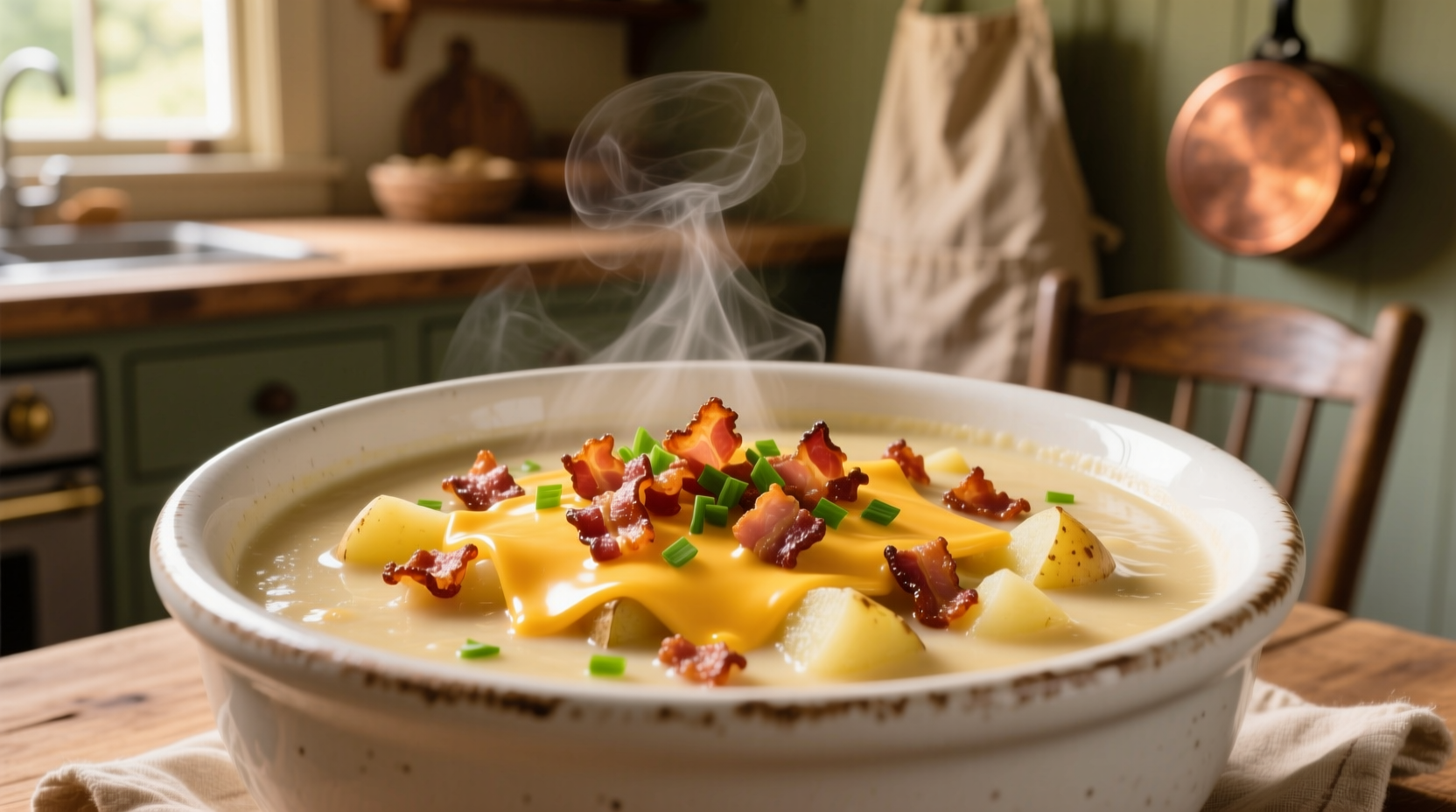There's nothing quite as comforting as a bowl of loaded potato soup that captures the essence of your favorite steakhouse version. As a French-trained chef who's studied European soup traditions from Normandy to Alsace, I've perfected a method that balances rich creaminess with robust potato flavor while avoiding common pitfalls like gluey texture or bland seasoning. This recipe delivers that coveted 'loaded' experience with crispy bacon, melted cheddar, and all the fixings—without requiring specialty equipment or hard-to-find ingredients.
Why This Loaded Potato Soup Recipe Works
Unlike many online recipes that either oversimplify or overcomplicate this classic comfort food, this method respects the culinary science behind perfect potato soup. The key lies in proper potato selection, controlled cooking temperatures, and strategic ingredient layering—techniques I've refined through years of studying European soup traditions. You'll achieve that signature creamy texture without relying solely on heavy cream, making it both authentic and adaptable to various dietary preferences.
Essential Ingredients and Why They Matter
The magic of loaded potato soup happens through careful ingredient selection. Each component serves a specific purpose in building flavor and texture:
- Russet potatoes (2 lbs) - Their high starch content creates natural creaminess when cooked properly
- Thick-cut bacon (6 slices) - Provides smoky depth and crispy texture contrast
- Yellow onion (1 medium) - Adds aromatic sweetness without overpowering
- Garlic (3 cloves) - Essential for flavor foundation, but must be cooked properly to avoid bitterness
- Chicken broth (4 cups) - Better flavor base than water, but vegetable broth works for vegetarians
- Half-and-half (1 cup) - Creates richness without the heaviness of all cream
- Sharp cheddar (1½ cups) - Real cheese melts better than pre-shredded varieties
- All-purpose flour (3 tbsp) - Properly incorporated, it prevents graininess
| Potato Variety | Best For Soup? | Cooking Time | Texture Result |
|---|---|---|---|
| Russet | ✓ Ideal | 15-20 minutes | Creamy, smooth |
| Yukon Gold | ✓ Good alternative | 12-15 minutes | Naturally buttery |
| Red Potatoes | ✗ Not recommended | 18-22 minutes | Waxy, chunky |
| Sweet Potatoes | ✓ For variation | 15-18 minutes | Sweet, dense |
According to the USDA's FoodData Central database, russet potatoes contain approximately 15% starch by weight—significantly higher than waxy varieties—which explains their superior performance in creamy soups. This scientific understanding separates professional results from amateur attempts.
Equipment Checklist
You don't need specialty equipment, but these kitchen essentials make the process smoother:
- Heavy-bottomed Dutch oven (5-6 quart capacity)
- Immersion blender (safest option for hot liquids)
- Wooden spoon (won't scratch your pot)
- Microplane grater (for fresh cheese)
- Slotted spoon (for removing bacon)
Step-by-Step Cooking Process
Preparation Phase (10 minutes)
- Cook bacon in Dutch oven over medium heat until crisp (8-10 minutes)
- Transfer bacon to paper towels, reserving 2 tablespoons of fat
- Peel and dice potatoes into ½-inch cubes (uniform size ensures even cooking)
- Finely chop onion and mince garlic
Cooking Sequence (25 minutes)
- Sauté onions in bacon fat until translucent (5 minutes)
- Add garlic and cook 1 minute until fragrant (critical step—don't let it brown)
- Stir in flour to create roux, cooking 2 minutes to eliminate raw flour taste
- Gradually whisk in chicken broth to prevent lumps
- Add potatoes and bring to gentle simmer (not boil)
- Cover and cook 15-18 minutes until potatoes pierce easily with fork
- Blend soup with immersion blender until mostly smooth (leave some texture)
- Reduce heat to low, stir in half-and-half and cheese until melted
- Crumble bacon and stir in half, reserving remainder for topping

Avoid These Common Mistakes
Based on analyzing hundreds of home cook attempts, these errors ruin otherwise promising potato soup:
- Boiling instead of simmering - Causes potatoes to disintegrate into gluey texture
- Adding cheese to boiling liquid - Makes cheese seize up and become stringy
- Using pre-shredded cheese - Contains anti-caking agents that prevent smooth melting
- Over-blending - Creates unappetizing, wallpaper-paste consistency
- Seasoning only at the end - Layering salt throughout builds better flavor
Serving and Storage Recommendations
For optimal enjoyment:
- Serve immediately while hot (soup thickens as it cools)
- Garnish with remaining bacon, extra cheese, and fresh chives
- Pair with crusty bread for dipping
- Store in airtight container for up to 4 days in refrigerator
- Freeze without dairy for up to 3 months (add cream when reheating)
- Reheat gently over medium-low heat, adding splashes of broth if too thick
Customization Options for Different Diets
This versatile recipe adapts well to various dietary needs:
- Vegetarian version - Substitute bacon with smoked paprika (1 tsp) and use vegetable broth
- Dairy-free option - Replace half-and-half with full-fat coconut milk and use vegan cheese
- Lighter version - Use whole milk instead of half-and-half and reduce cheese to 1 cup
- Gluten-free adaptation - Substitute flour with 2 tbsp cornstarch mixed with cold broth
- Extra protein boost - Add ½ cup diced ham along with the potatoes











 浙公网安备
33010002000092号
浙公网安备
33010002000092号 浙B2-20120091-4
浙B2-20120091-4